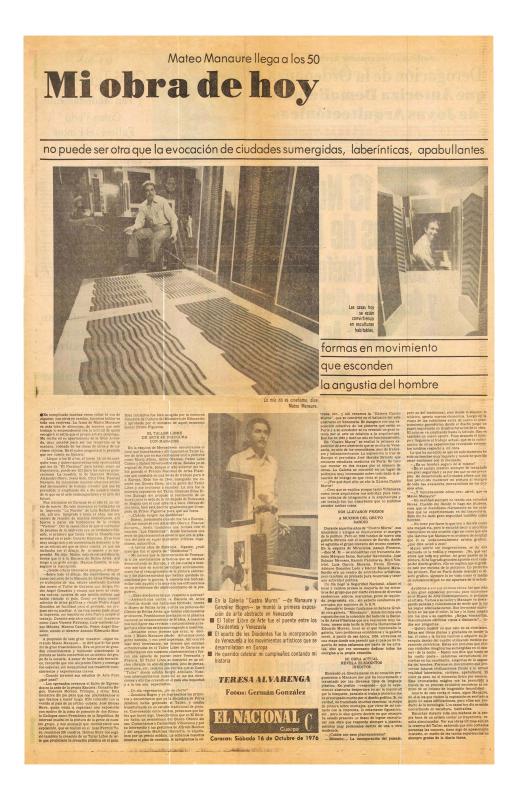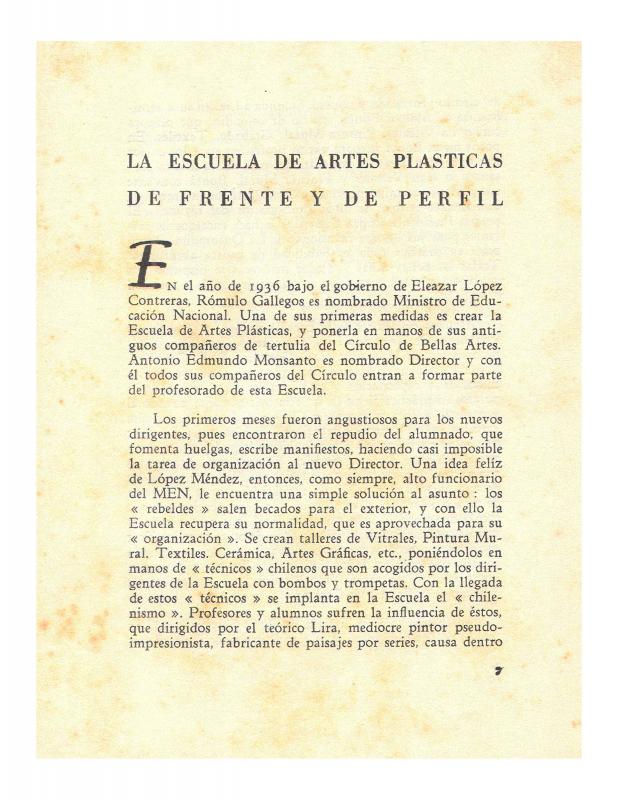In 1977, the Museo de Arte Contemporáneo de Caracas organized the exhibition Columnas policromadas by the Venezuelan painter Mateo Manaure (b. 1926). The show presented a series of works based on the repetition of lines (creating a volumetric effect or sense of vibration). In connection with the exhibition, the Venezuelan docent Gloria Carnevali gathered some of the artist’s statements for her criticism, using information relevant to this series. This was one of the artist’s last presentations made in the sphere of Abstract art before he went back to figurative art (in 1981). Carnevali highlights Manaure’s comments on the technique he used in executing these works to achieve the appearance of certain volumes and color effects. Similarly, she notes the artist’s mention of the individuals who were working in this process his studio at the time. In this regard, the writer focuses on the serial repetition of the module, explaining Manaure’s relationship to solutions found in graphic design, a discipline the artist practiced as early as the 1950s. Though reluctant to be linked to Kinetic art, his approach always evokes the optical effects typical of that trend, which had a major impact on the Venezuelan visual arts scene during the 1970s, extending to urban public spaces as well. In fact, one of Manaure’s polychrome columns was incorporated into the Plaza La Concordia, in Caracas, as a part of an urban restoration project. Finally, the desire to evoke concrete themes (light, nighttime) through an Abstract art approach reveals the tensions in the artist’s work between geometric and figurative art. This could be considered evidence of Manaure’s profound vocation to create lyrical artworks.
[Regarding Manaure’s work, see the following texts in the ICAA digital archive: by Víctor Guédez “La creación estético-visual en Mateo Manaure” (doc. No. 1155531); by Roberto Guevara, both “Manaure y la inmensa noche” (doc. No. 1156411) and “Manaure: Columnas en tierras movedizas” (doc. No. 1155301) as well as “Manaure y las Cuvisiones” (doc. No. 1156459); by Perán Erminy “Las imágenes poéticas de Manaure” (doc. No. 1156523); by Alfredo Boulton “Mateo Manaure en el Museo de Bellas Artes” (doc. No. 1157497); by Gastón Diehl “Mateo Manaure” (doc. No. 1156491); one article by Teresa Alvarenga “Mi obra de hoy: Mateo Manaure llega a los 50 años” (doc. No. 1156427) and another by Pedro Lhaya “Mateo Manaure o la autenticidad pictórica americana” (doc. No. 1156443); and finally, an article by Alejo Carpentier, ‘Letra y Solfa: Arte abstracto” (doc. No. 1097108). In addition, there are two texts by Manaure himself, “La decisión de un artista” (doc. No. 1156475) and an essay on “La Escuela de artes plásticas de frente y de perfil” (doc. No. 813569)].












